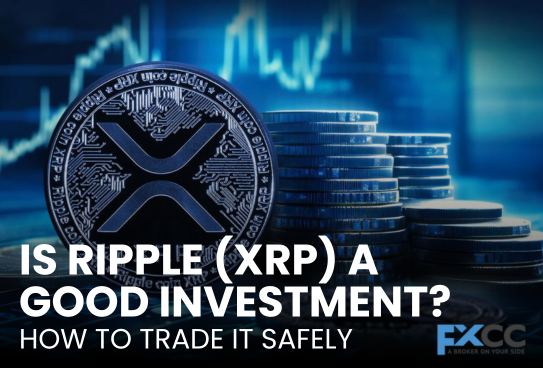Ripple (XRP) has become a major focus for cryptocurrency investors interested in fast, cost-effective cross-border payments. Developed by Ripple Labs in 2012, XRP serves as both a digital currency and bridge asset, aiming to facilitate seamless global transactions for financial institutions. But is it a good investment? This article reviews XRP’s unique features, potential as an investment, and tips for trading it safely.
Understanding Ripple (XRP): What Makes It Unique?
Ripple is both a digital payment platform and a currency, with XRP designed to streamline cross-border payments. Unlike Bitcoin, which operates independently as a decentralized network, Ripple works closely with banks and financial institutions to make international transactions faster and cheaper.

Key Advantages of Ripple Over Other Cryptocurrencies
- Transaction Speed and Cost: XRP processes up to 1,500 transactions per second, far outpacing Bitcoin’s seven transactions per second, making it one of the fastest cryptos for cross-border payments.
- Bank Partnerships: Ripple’s collaborations with banks like Santander and American Express give it a unique advantage, potentially driving up the adoption of XRP.
- Pre-mined Supply: Unlike many cryptos, Ripple pre-mined its total supply of XRP, which brings up concerns about centralization, as Ripple Labs holds a substantial portion of it.
Is Ripple (XRP) a Good Investment? Weighing Pros and Cons
Deciding if XRP is a worthwhile investment requires considering its advantages and risks.
Pros of Investing in XRP
- Strong Institutional Partnerships: Ripple’s alignment with traditional financial institutions may boost its long-term value as more banks adopt its blockchain technology.
- Real-World Use Case: Ripple’s practical focus on cross-border payments makes it valuable to businesses and financial systems, which could drive demand for XRP.
- Lower Fees, Faster Transactions: XRP offers low-cost transactions with a fast processing time, qualities that make it a feasible solution for high-volume transfers.
Cons of Investing in XRP
- Regulatory Uncertainty: Ripple’s ongoing legal battle with the U.S. Securities and Exchange Commission (SEC), which claims XRP is a security, creates an unpredictable future that may affect its value.
- Centralization Concerns: Ripple Labs’ control over a large portion of XRP raises questions about decentralization, which could affect investor confidence in its long-term value.
- Volatile Market: As with all cryptocurrencies, XRP’s price fluctuates widely, making it a risky asset that can yield high returns or steep losses.
How to Trade Ripple (XRP) Safely
Trading XRP can be risky without the right precautions. Here are a few strategies to trade safely:
1. Choose a Reliable Exchange
When trading XRP, use a reputable cryptocurrency exchange like Coinbase, Binance, or Kraken. These platforms provide security features like two-factor authentication (2FA), which adds an extra layer of protection to your account.
2. Secure Your XRP in a Wallet
Consider moving your XRP to a secure wallet after purchasing it. Hardware wallets, like Ledger or Trezor, store your private keys offline, making them less susceptible to hacking than online wallets.
3. Stay Informed on Market News
Ripple’s value is closely tied to market trends, regulatory changes, and Ripple’s legal proceedings. Follow reputable cryptocurrency news sources and set price alerts to keep track of significant market movements affecting XRP.
4. Use Stop-Loss Orders
Due to XRP’s volatility, setting stop-loss orders can protect your investments. This tool allows you to automatically sell your XRP if it falls below a certain price, minimizing potential losses. Similarly, take-profit orders let you secure gains once the price hits a target.
5. Avoid High Leverage Trading
Leverage amplifies gains but also increases risks, especially with volatile assets like XRP. New traders should avoid high leverage until they have more experience, as it can quickly lead to liquidation if prices move unexpectedly.
Future Outlook for Ripple (XRP)
Ripple’s future largely depends on the outcome of its legal case with the SEC and how regulations evolve in the cryptocurrency space. A favorable legal decision could increase confidence in XRP and potentially attract more institutional adoption. However, if Ripple is deemed a security, XRP could face additional restrictions that impact its market appeal and value.
Ripple’s existing partnerships with banks and the efficiency of its payment solutions indicate potential for growth, but the risks of volatility and regulatory changes mean that investors must proceed with caution.

Conclusion
Ripple (XRP) has the potential for significant growth, thanks to its partnerships with financial institutions and focus on cross-border payments. However, it’s essential to weigh these strengths against regulatory uncertainties and the volatility that comes with cryptocurrency investments. If you choose to invest in XRP, prioritize safe trading practices like using reputable exchanges, securing your assets in a hardware wallet, and setting stop-loss orders. With a cautious approach, XRP can be part of a diversified portfolio, but only for investors prepared for its risks.


